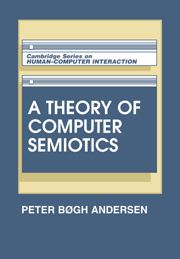 A Theory of Computer Semiotics
A Theory of Computer Semiotics Book contents
- Frontmatter
- Contents
- Preface to second edition
- PART I THEORY
- PART II COMPUTERS
- PART III LANGUAGE, WORK, AND DESIGN
- Introduction
- III.1 Language as interpretation. Semantic fields in the Postal Giro
- III.2 Language as action. Language games in the Postal Giro
- III.3 Task analysis. Controlling control.
- References
- Index
III.2 - Language as action. Language games in the Postal Giro
Published online by Cambridge University Press: 26 March 2010
- Frontmatter
- Contents
- Preface to second edition
- PART I THEORY
- PART II COMPUTERS
- PART III LANGUAGE, WORK, AND DESIGN
- Introduction
- III.1 Language as interpretation. Semantic fields in the Postal Giro
- III.2 Language as action. Language games in the Postal Giro
- III.3 Task analysis. Controlling control.
- References
- Index
Summary
A psychological definition of language games
In the preceding section, I showed how to use semantic fields of lexical material for various purposes: when the system developer enters the organization she can use them to get an impression of conceptual differences of the organization, when she starts doing particular applications she can use them to design the general data structure, and when she has made a prototype, semantic fields are useful for evaluating its reception and for redesigning it. Finally, researchers studying the general effects of computerization on organizations can use semantic fields to record language changes in the organization, and use these data as a basis for setting up hypotheses about changes of culture and cognition.
However, language is more than a vehicle for interpretation and description. Besides the ideational functions, language also has an action aspect that is subsumed under Halliday's interpersonal functions.
Although it is not a bad idea to start with the ideational aspect, since professional languages are registers and tend to differ in vocabulary, the action aspect is equally important in systems development. Language in work situations is not only used to interpret and describe, but also to act verbally, and in a similar way, computer systems are used as media for distributing work, giving orders, and reporting. Designers not only need to know which kind of information is needed and how it should be structured semantically, they also need to know when it is needed and for which purposes.
Information
- Type
- Chapter
- Information
- A Theory of Computer SemioticsSemiotic Approaches to Construction and Assessment of Computer Systems, pp. 371 - 424Publisher: Cambridge University PressPrint publication year: 1991